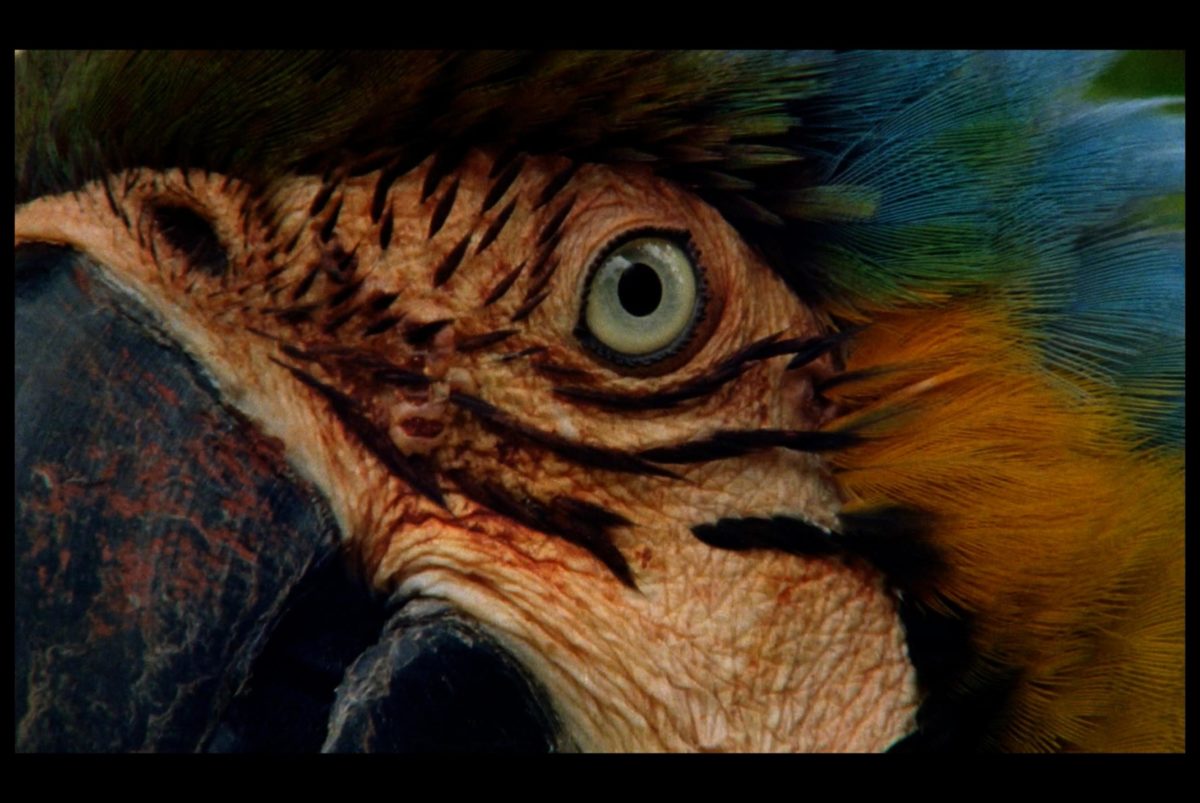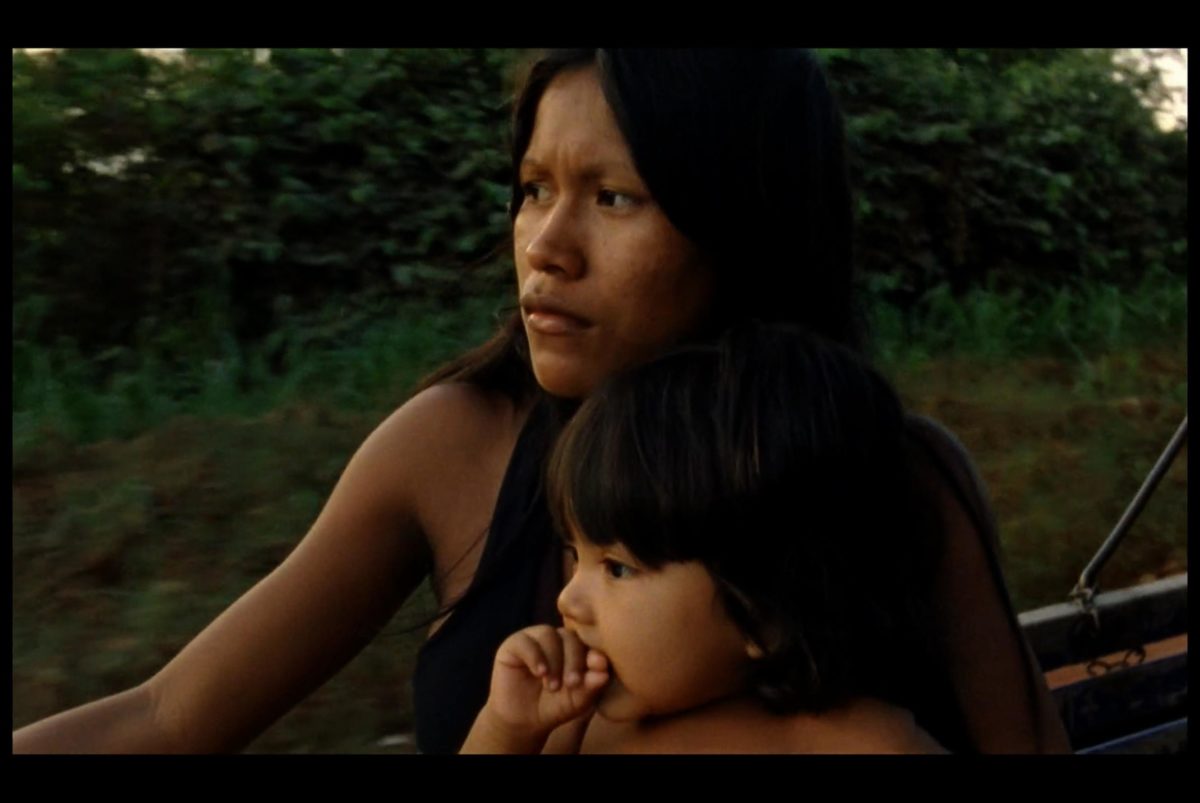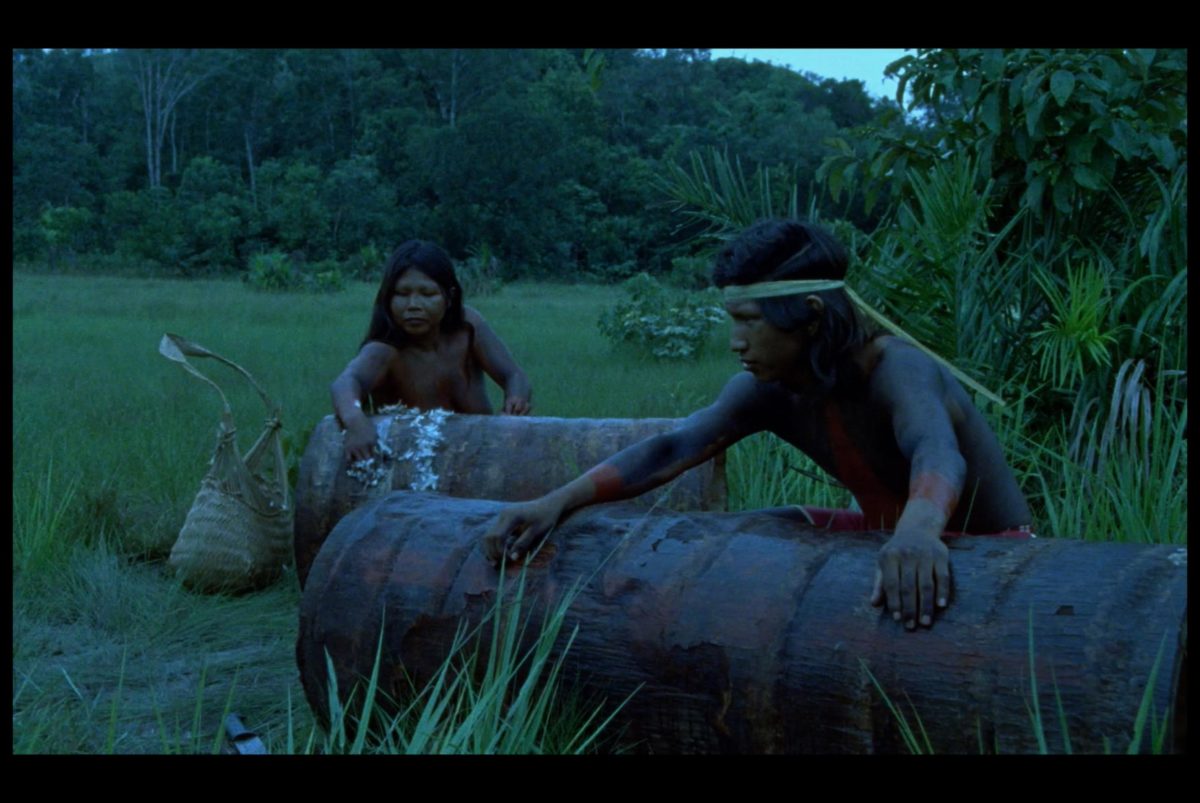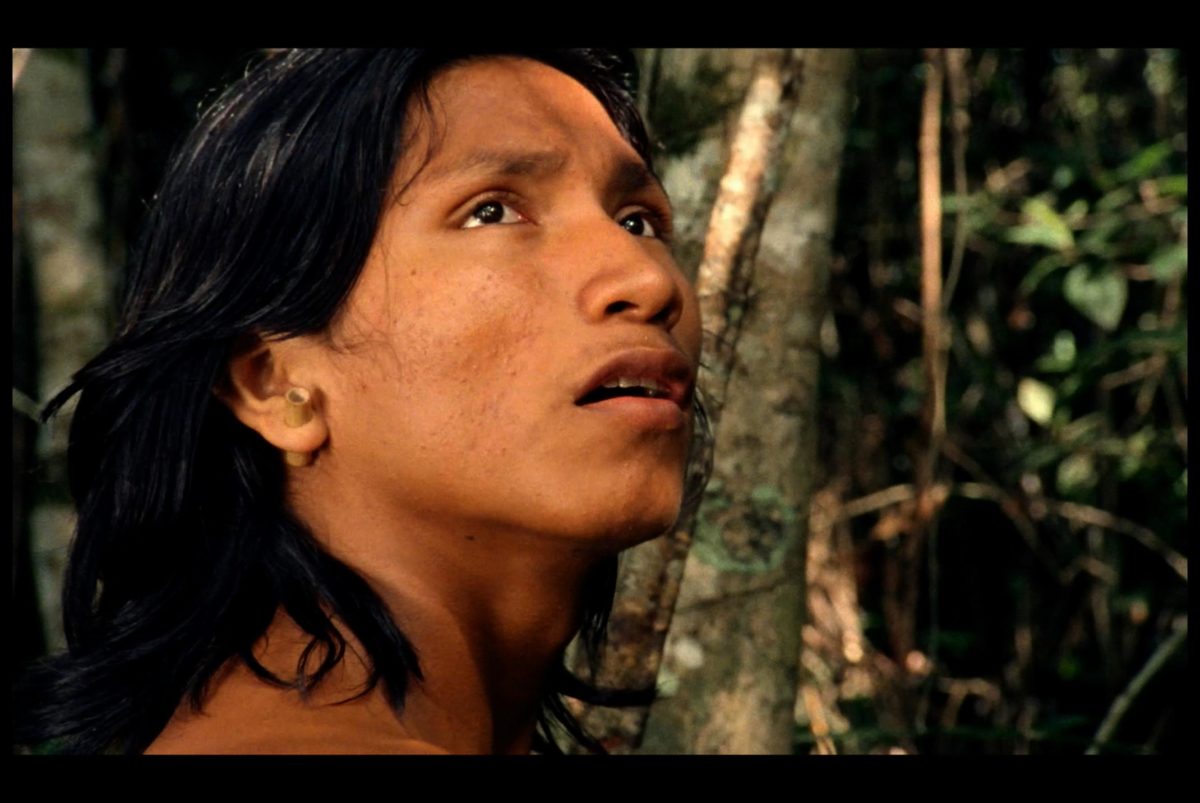In the opening scene of The Dead and the Others (Chuva É Cantoria Na Aldeia Dos Mortos, João Salaviza and Renée Nader Messora, 2018), teenage father Ihjãc (Henrique Ihjãc Krahô) dreams of his dead father. He ventures outside his hut at midnight to the waterfall by his village and calls out to him, as his dream suggested. Ihjãc’s father replies, from the ether, from somewhere between the dead and the living, and this sets the tone for the things to come. As much as the film captures the traumas experienced by the Krahô — an indigenous group in Northern Brazil —, it places these issues on equal footing with the afterlife and the mystical. The gap between these two poles of life and afterlife is quite close, bridged even further by shamans, essential to the Krahô community. Central to the film is Ihjãc’s discovery of his powers as shaman, and the loneliness that comes with being caught in between worlds.
The Dead and the Others is part coming-of-age tale and part Apichatpongian ethnofiction cinema set in the fringes of Brazil. Its languorousness recalls the Thai auteur’s films while the bildungsroman that is the template for the plot is a logical continuation of the Portuguese directors’ previous works. João Salaviza and Renée Nader Messora have a history of collaboration from films like the Lisbon-set Montanha (2015), a coming-of-age film that like The Dead and the Others also features a teenage boy dealing with the death of a paternal figure, and, more recently, Russa (2018), a short documentary about a former prison inmate who goes through forced relocation, an issue that is also present in Salaviza’s Altas Cidades de Osadas (High Cities of Bone, 2017).
Although set in Brazil, which is replete with its own set of issues, The Dead and the Others fits the mold of Apichatpong Weerasethakul’s idea of ethnographic cinema as shown in films like Mysterious Object at Noon (2000) and Tropical Malady (2004). According to Matthew P. Ferrari, Apichatpong’s narrative works can be labelled as “sensational inaction cinema”. The same quality can be found in Salaviza and Messora’s film. It exists at the intersection of the arthouse mode of narrative and the documentary. Though a plot is in place that pushes the story to its end, the filmmakers do not seem overly concerned with the trajectory, instead choosing to observe mundane moments in the village Ihjãc belongs to. The camera lingers on the Krahô and their activities, no matter how limited or repetitive the action is within the frame.
The film’s historical background is the 1940 Krahô massacre, where 26 members of the community were murdered by ranch owners. It is recounted in a sequence that stylistically sticks out because of how it resembles talking head documentaries, which is quite a departure from the film’s predominant wide shots and long takes. However, this is warranted as the massacre is a particularly salient event in the community’s history. Though it does not add to the progression of events, it provides a context to the alienation the group continues to experience. The static shots of elders calmly recounting their firsthand experiences of the massacre are disturbing in their stillness, the camera effectively capturing the inexpressible trauma within. The land disputes that ushered in the massacre are to this day unresolved and remain a pressing issue in Brazil. Consequently, in the film, the ways in which the world outside manifests and makes itself known to the Krahô are often politically charged and violent. It’s no wonder then that the urban, or simply, that which is outside the Krahô reservation, is viewed with skepticism.

In their brief midnight exchange, Ihjãc’s father asks him to prepare a funerary feast so that he can finally cross over to the village of the dead. He complies and begins to prepare the swiddenAn area of land that has been cleared by cutting the vegetation and burning it. for the feast. After their encounter, Ihjãc begins to manifest signs of being a shaman: he feels tired for no reason; his eyes and body feel hot “on the inside”; a macaw follows him around and speaks to him in the forest. No one, not even the village elder Old Crate, can whisk away the shaman in him. Old Crate says that the Macaw is Ihjãc’s master, one who is responsible for guiding him through his development as shaman, and so, if the Macaw wants him, he cannot escape. But Ihjãc wants to control his own fate. He seeks refuge in the city, even abandoning his wife Kôtô (Raene Kôtô Krahô) and child Tepto, in hopes that the Macaw “forgets him”. Thus begins his voluntary, though still painful, relocation from rural to urban, from the mystic to the pragmatic.
The colors and the soundscape reflect this shift. The muted and grey colors of the city, its concrete pavement, its buildings and walls — all are bled dry of vibrancy. Contrast this with the jewel tones of the Pedra Branca (the municipality where Ihjãc’s village is located), its lush green forests, the blue sky, even the mud — all is vibrant and brimming with life. The most vibrant figure of all is also the most mystical, most un-urban: the Macaw. Its plumage, shown in brief close-ups before Ihjãc faints, is a sight to behold. That only Ihjãc seems to see it — it is unclear if it is a vision or hallucination — makes it all the more enigmatic. Completing the tableau of the Pedra Branca is the layered sound design (by sound designer Pablo Lamar) of crickets, insects, ambient sounds, flowing rivers and waterfalls, the swishes of grass, among other sounds. The sonic atmosphere is noticeably less complex when Ihjãc arrives in the city, except for the cackle of the radio, the noise of neighbors and a pop song reminiscent of Despacito which Ihjãc somehow knows the lyrics to.
Assimilation into urban life is difficult for Ihjãc. He has no ability to express his experience to a nurse steeped in modern medicine. He cannot say that his phantom pain stems from his calling as a shaman. He can only say “my eyes are hot, my body is hot” and speak of the pain in terms she can understand. The nurse asks for his national ID but Ihjãc, having only been to town once before (during the birth of Tepto), doesn’t have any official identification. He is not used to being away from his community. This self-imposed exile continues until the communal home he stays at evicts him. He wanders the streets, a truly pitiful sight: a nomad in his own country.

The film’s final third focuses on the mourning ritual of the Krahô, after Ihjãc finally comes home. He has a change of heart when his wife Kôtô and child Tepto visit him. Just before they depart for Pedra Branca, Kôtô tells him, “Our life is not here. This is not our place.” Yet, for Ihjãc, Pedra Branca is not a suitable place either. But the funerary feast begins and Ihjãc’s frustrations take a backseat to the community’s rituals, of which there are many. All season, they cut down the crops in the swidden and burned down the remaining plants to allow space for the new crops to grow. They cut each other’s hair, with a thick horizontal line showing the scalp that separates the crown from the rest of their hair. They prepare meat laid out on manioc, which is then wrapped in leaves and cooked over open fire. They adorn hollow logs (one of which belongs to the deceased) and carry them in a log race. Finally, the community gathers around the deceased’s log and openly, audibly weeps, until the village chief gathers everyone in a hut and implores them to stop their grieving for it is now time to “think about the living”.
This abrupt end to mourning is a mechanism for the community to function as a whole and continue its duties and rituals despite the tragedy that has occurred. The subtext is that the community treats collective, larger grief, such as the 1940 massacre, in the same way. Ihjãc is an outlier because his grief stays with him and he does not know what to do with it. In an aside, Ihjãc tells Kôtô, “Things have changed. I’m not the same anymore. The mecarõ… I can see them now. I know the soul of things. They talk to me. Now I’m like this. What can I do?” Ihjãc realizes, to his dismay, that his transition to shamanism is complete when he sees the mecarõ — animals, spirits, and other entities which only shamans can see.

The film ends the way it begins. It is bookended by sequences at the waterfalls where Ihjãc first spoke to his father. The father doesn’t speak to him when he returns, or at least not audibly. In fact, in the final moments, there are no words nor sounds except for the incessant rush of the water. Ihjãc finally takes up his father’s invitation in that first meeting and follows him into the depths of the waters. As Ihjãc joins the ranks of the Dead, he expresses his refusal to be Other, like the living who have to go on being marginalized in their own land. In a film where death is only a portal into another world, Ihjãc’s decision is laudable, even brave. In a sense, he has grown up, completed the coming-of-age arc, but his refusal to go on is a sign of stilted development. He does not belong to the city, as he has learned during his arduous stay there, but as shaman, seeing the ghosts no one else sees, he can no longer live in the community either. In such a liminal space, he feels confined and lonely, neither being with his people nor with his father and all that have departed — so in the end he makes his choice.
As Ihjãc becomes a shaman and intermediary between the living and the dead, Salaviza and Messora become mediators connecting their colonial past with the present and transmitting the history of the Krahô to a foreign audience. “I want to film other places. I would very much like to film in Brazil. That’s where my roots are. I’m the third generation of links between Portuguese and Brazilians in my family,” says Salaviza in a 2015 interview with Venice International Film Critics’ Week. At Cannes, where The Dead and the Others won the Special Jury Prize, the cast and crew gathered for a protest, with signs calling for the end of the genocide of Brazil’s indigenous people and the return of their ancestral lands. In occupying this space of in-betweenness, they speak for the people of the Krahô (or with them, as the film is a collaboration) without speaking over them, a fine line to walk when in a position of privilege as a filmmaker. It is a position that they navigate well. Through the careful handling of the trauma-laden history of the Krahô, their direction of first-time actors, and nuanced treatment of the rituals and traditions of the community, the filmmakers transport their audience into this foreign world and culture, letting the Other speak for themselves.
